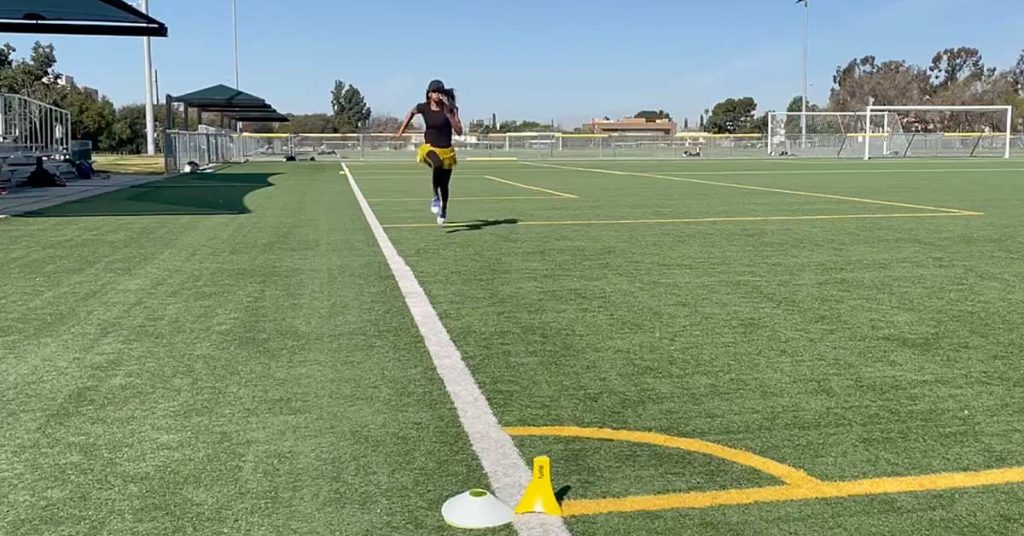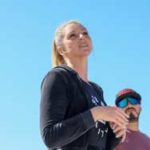
Ciara Murray is a speed and performance coach at Spellman Performance. She has a background in physical therapy and has coached various levels from youth to elite. Her focus is on speed development and preparing athletes for the physical demands of college and pro football. Murray has prepared college football players for the NFL Combine and is involved in off-season programming for NFL players.
Freelap USA: As a speed coach with Spellman Performance, you’ve prepared quite a lot of college football players for the NFL Combine and coached football players from youth level up to the NFL in recent years. What´s the most challenging and the most exciting part of the Combine prep for you as a coach?
Ciara Murray: Pre-draft prep is one of the most exciting—yet one of the most stressful—parts of our year. We have an eight-week timeframe to prepare these guys for one of the most important events of their careers. This year, we worked with three different groups in three different locations, so it was a huge demand to find the perfect balance between programming for QBs, skill guys, and offensive linemen. Luckily enough, Les Spellman is an absolute genius, and our data team behind the scenes worked endlessly on kinematic data so we could get a full profile on each athlete and determine who needed more focus and in which areas.
It also is such a mentally demanding time, so making sure they had all the tools, resources, and reps going into that process was a huge goal. The most exciting part is always building relationships and creating trust with the guys and the team and being able to follow that all the way up until the draft process to see their families’ faces when their name gets called or they get signed. All we can work for as coaches in this phase is making sure the athlete is healthy and well-prepared, and I think we did a great job of that this year.
Freelap USA: What fascinates you about speed and why have you decided to coach mainly speed?
Ciara Murray: In all honesty, I was a mediocre (at best) athlete in a sport that didn’t focus on speed at all. I started off professionally in the physical therapy realm and gradually transitioned into concentrating on high performance. I have always been interested and invested in movement and sports, and I have been passionate about progressing athletes in their field. When I connected with Les, everything changed for me. I saw how passionate he was and how much was still untouched in the speed world, so I put my head down and got to work.
It has taken a lot of research and a lot of reps to get comfortable and familiar in the field, but I am constantly progressing and learning and making mistakes and getting better. It’s all part of the process, and I am blessed to be a part of such a knowledgeable and supportive team.
Freelap USA: Mobility plays an important role in your program design. Can you explain how you implement mobility drills into your warm-up when preparing athletes for top-speed sprinting? Which drills are useful, and are there any that you would consider a waste of time?
Ciara Murray: Mobility is huge in our warm-up and activation phase. Our sessions always start off with a series of prehab exercises that focus on activation of the hips, glutes, hamstrings, and lower extremities.
Our warm-up and activation phase is arguably the most important factor in preparing our athletes for the forces and adaptations of a heavy speed session, says @cicimurray. Share on XWe try to incorporate isometrics as well, followed by an extensive dynamic warm-up. All of our dynamic stretching and thermogenics are at the front side of our sessions, to raise the body temperature and prime the muscle groups, and static stretching is done afterward. We often end our session with a rudimentary series and/or barefoot walks to build the foot’s intrinsic muscles and stress ankle stiffness. Our warm-up and activation phase is arguably the most important factor in preparing our athletes for the forces and adaptations of a heavy speed session, with an intentional cooldown at the end.
Freelap USA: When you start coaching a new group of collegiate athletes, how do you create buy-in and commitment to the process?
Ciara Murray: I’ve been getting this question a lot—as I continue in this field, I notice that the buy-in process is different with every athlete I come across. It’s unlikely that you see me the first day and automatically think: Okay, this girl knows what she’s talking about, I’m in. I don’t take offense to that; I see it as a challenge accepted.
I’ve actually noticed a more gradual process with younger athletes. Knowing how to control the room amongst college guys and pros is the easy part for me, the youth is where the focus comes in. The process takes time and attention to how individual athletes operate. Some athletes might buy in day one because I gave them a helpful cue, the other half buy in after weeks of constructive communication and knowing what they need. Some athletes prefer to show up to a session and not say a word, and others like to laugh and joke around and vibe out. The work remains the same on my end.
If there’s one thing I’m good at, it’s the ability to read the room. Some of the best relationships I have with my athletes come from understanding when they do and when they don’t want to talk. Being able to understand where someone is coming from and having their best interest is the best buy-in process, because either way I am going to be myself and do my best as a coach and trainer. And athletes can detect authenticity—they’ve been around enough people in their career to know who has their best interests in mind and who just wants a piece of the pie.
Athletes can detect authenticity—they’ve been around enough people in their career to know who has their best interests in mind and who just wants a piece of the pie, says @cicimurray. Share on XFreelap USA: What advice would you give young strength and conditioning coaches who want to gain knowledge and experience in speed development and coaching sprints for team sports? What do they need to know about technology, tracking data, and analysis?
Ciara Murray: Like I said previously, there is still so much research going on in the speed world, and I am so lucky to be part of a team that’s at the front of that. Our team utilizes technology from lasers, GPS, Output Sports, and more as a means of collecting data. It just comes down to maintaining that data over time and seeing which bucket the athletes fall into.
We have launched our technology platform, Universal Speed Rating, which can be utilized by coaches and athletes to train and track performance, as well as rank athletes among the rest of the world in terms of speed and skill level. We provide access to programs, drills, educational content, and the ability to track training progress. Plenty of people can train speed, but the ability to track data and make use of it is the key.
The beauty of the internet and social media is the accessibility of resources. Spellman Performance, Universal Speed Rating, and I put out educational information every single day, on every single platform, for free. We not only want athletes to be able to use our programs, but also coaches to use our systems and our educational courses to develop their own athletes. No competition—we’re all in this together.
Since you’re here…
…we have a small favor to ask. More people are reading SimpliFaster than ever, and each week we bring you compelling content from coaches, sport scientists, and physiotherapists who are devoted to building better athletes. Please take a moment to share the articles on social media, engage the authors with questions and comments below, and link to articles when appropriate if you have a blog or participate on forums of related topics. — SF

